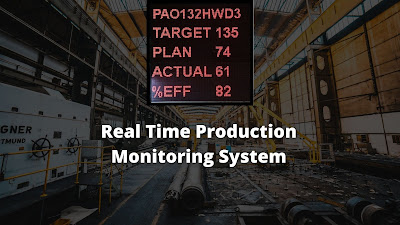In this competitive market, companies cannot afford the waste of time and resources by the employees to perform work that can be done in a faster and better way with advanced solutions. One of the best-advanced solutions can be a real time PMS. It is a production tool that collects and distributes necessary data when various events occur on a shop floor. Its main aim is to prevent small disturbances having large effects. Hence there will be a decrease in the number of unscheduled production Stops, improve cost-efficiency and simplify the production planning.
The main task of a PMS is to collect and distribute real time data of events on the shop floor. This data which is obtained is understandable and useful for decision making. The data which is monitored should help the production team to respond timely to the events otherwise it may affect the desired result. If there are any changes system should also alarm and inform respective department concerning all recognized faults.
Production Monitoring System is not used just as display boards that show production data, it is also used for a reporting and administration module, the stored data can be analyzed to find trends, projections, and estimations for easier decision making and production planning. The detected faults will decrease time wastage and will improve overall equipment effectiveness.
The main task of a PMS is to collect and distribute real time data of events on the shop floor. This data which is obtained is understandable and useful for decision making. The data which is monitored should help the production team to respond timely to the events otherwise it may affect the desired result. If there are any changes system should also alarm and inform respective department concerning all recognized faults.
CONCEPT OF A PRODUCTION MONITORING SYSTEM
Production data which is collected on the shop floor may be incorrect; this may be mostly due to human intervention or improper production monitoring system. Here the human factor is more common in this case.The PMS capture most of the required data without any human intervention. When an unscheduled outage does happen, time is spent in notifying support resources for which the problem has occurred, time is spent troubleshooting and finally time is spent to resolve the problem. But predictive nature of continuous remote monitoring more often avoids unscheduled outages by addressing the issues before they affect machine operation and product quality.
The benefit of installing an efficient real time PMS is the immediate access to all required production related information by the relevant personnel. And it should be enough data to clearly identify the reasons of production stops, time loss etc. At the same time, presenting too much information can confuse or even distract operators. The most important requirements of any PMS are that the system is economical, accurate and easy to set up on a production line. And it has to be capable of providing straightforward connectivity to switches, sensors, PLC outputs and other common industrial equipment. If the true production data can be automatically captured and presented in a simple, understandable way to the operators, they will become a more integral part of the improvement process. Relatively simpler systems may have greater potential for real-time control. An effective production monitoring system should be at least comprised of the four elements such as collection, display and analysis.
Advantages of Industrial PRODUCTION MONITORING SYSTEM
1. Increased efficiency
Industrial robots have a capacity to complete certain tasks faster and better than people, they are designed to perform certain tasks with a higher accuracy level. The fact that they are used to automate processes because previously might have taken significantly more time and resources, it means that you can often use industrial robots to increase the efficiency of your production line.
2. Higher quality
Due to their high level accuracy, this system can also be used to produce higher quality products which have certain standards of quality, also reducing the time needed for quality control.
3. Improved working environment
Industrial robots are often used for perform tasks which are may be dangerous for humans, as well as being able to perform highly laborious and repetitive tasks. Overall, by using automation you can improve the working conditions and safety in your factory. This system doesn’t get tired and make dangerous mistakes, neither do they suffer from repetitive strain injury.
4. Increased profitability
By increasing the efficiency and speed of your production process, reducing the resource and time needed to complete it, we obtain the quality products, hence this system be used to achieve higher profitability levels, with lower unit cost per product.
5. Longer working hours
Typically people tend to have breaks, get distracted and after time attention there work becomes slow. With automated system it can work 24/7, and keeps running at 100%. If we replace one person on a key process in a production line with a system the output increases by 40% in the same working hours. Robots also don’t take holidays nor have unexpected days off sick.
Disadvantages of Industrial Robots
1. Capital cost
Whilst industrial automated system can prove highly effective and bring you a positive ROI, implementing them might require a huge capital cost. That’s why, before making a decision we recommend considering both the investment needed and also the ROI we expect to achieve. Often the easiest way to get round this issue is to take out asset finance and the ROI of the robot more than pays for the interest on the asset finance.
2. Expertise
Whilst industrial system is excellent for performing many tasks, as with any other type of technology, employs require more training and expertise to initially set up. The expertise of a good automation company with a support package will be very important to train the operators.







0 Comments